As an Amazon Associate KitchenwareSets.com earns from qualifying purchases.
Open Concept Kitchen Dining Living Room Genius Ideas For Small Spaces
It promises breezy, connected living, but often a small open concept kitchen, dining, and living room feels more like a puzzle with missing pieces. You have this one large room, but how do you make it feel like three distinct, functional spaces without it becoming a cluttered, disjointed mess? If you’re struggling with awkward furniture arrangements and a lack of cohesion, you are not alone.
Many homeowners feel stuck when decorating an open concept living room, especially in a small space. It’s a common challenge where the kitchen’s mess seems to spill into your relaxation zone, and the dining area feels like an afterthought floating in between. The dream of a spacious, airy home can quickly turn into the reality of a single, undefined room that serves no function well.
Designing a small open-concept kitchen, dining, and living room involves creating distinct functional zones without walls. This is achieved through strategic furniture placement, the use of area rugs to anchor spaces, a cohesive color palette, and multi-functional furniture to maximize every square foot. As a design strategist who’s helped countless homeowners tackle this exact challenge, I know the secret isn’t more space—it’s smarter strategy. This guide provides a step-by-step plan with genius, practical ideas to transform your space from chaotic to cohesive.
Feeling Overwhelmed by Your Small Open-Concept Space?
The core challenge of designing a small open-concept area is creating distinct functional zones without using physical walls. This is achieved by employing strategic design principles such as using furniture and area rugs as visual dividers, maintaining a cohesive color palette to unify the space, and selecting smart, multi-functional furniture to maximize utility. By focusing on these strategies, you can transform a cramped and undefined layout into a harmonious and highly functional home that feels both spacious and organized.
The Foundation: 3 Core Principles for Open-Concept Success
The three core principles for a successful small open-concept design are: 1) Create distinct zones using furniture and rugs as “soft” dividers. 2) Maintain visual cohesion with a unified color palette, flooring, and style. 3) Maximize functionality with smart, multi-purpose furniture and vertical storage. Mastering these fundamentals is the key to unlocking your space’s true potential before you even think about specific decor.
- Defining Zones: This is about creating invisible rooms. You’ll use furniture placement, area rugs, and lighting to signal where the kitchen ends and the living room begins. Each zone should have a clear purpose, which prevents the entire space from feeling like one big, confusing room.
- Ensuring Visual Cohesion: While the zones are distinct, they must feel like they belong together. This is achieved through a consistent color palette, repeating materials or finishes (like wood tones or metal hardware), and a single type of flooring that flows seamlessly throughout the entire area. This visual thread is what makes the space feel intentional and harmonious.
- Maximizing Functionality: In a small space, every item must earn its keep. This means choosing furniture that is proportionate to the room and, whenever possible, serves more than one purpose. Thinking vertically with shelving and storage is also critical to keep precious floor space clear and uncluttered.
7 Genius Ideas to Perfect Your Small Open Concept Kitchen, Dining & Living Room
Ready to move from theory to action? Here are seven clever, designer-approved strategies that solve the biggest challenges of a small open concept kitchen, dining, and living room. These aren’t just theories; they’re proven strategies curated from top interior designers and tested in real small homes. Think of them as your toolkit for creating a space that is as functional as it is beautiful.
- Define Zones with Area Rugs
- Create “Invisible Walls” with Furniture
- Unify with a Cohesive Color Palette
- Layer Your Lighting to Create Ambiance
- Choose Smart, Multi-Functional Furniture
- Go Vertical: Maximize Wall Space
- Create a Seamless Flow with Consistent Flooring
1. The Rug Trick: Define Your Zones with Strategic Area Rugs
The easiest and most effective way to define separate areas in an open floor plan is by using area rugs to visually anchor your furniture groupings. An area rug acts like a foundation for a “room,” clearly delineating the living room seating area or the dining space from the rest of the open layout.
Materials Needed:
* Measuring tape
* Appropriately sized area rugs (one for the living area, one optional for the dining area).
Step-by-Step Directions:
1. Measure Your Zone: First, measure the intended “living room” area where your main seating arrangement will be.
2. Select the Right Size: Choose a rug that is large enough so that at least the front two legs of your sofa and any armchairs can rest comfortably on it. This visually anchors the entire furniture grouping and makes it feel like a cohesive unit.
3. Position for Definition: Place the rug to create a clear boundary. The edge of the rug acts as a visual “line” that separates the living zone from the kitchen or the main traffic pathway.
4. Consider a Second Rug: For your dining area, you can use a second rug. Ensure it is large enough for the chairs to remain completely on the rug, even when they are pulled out from the table.
Pro-Tip: Don’t be afraid to layer rugs or use different-but-complementary patterns to add texture, but keep the color palette consistent to avoid a disjointed look.
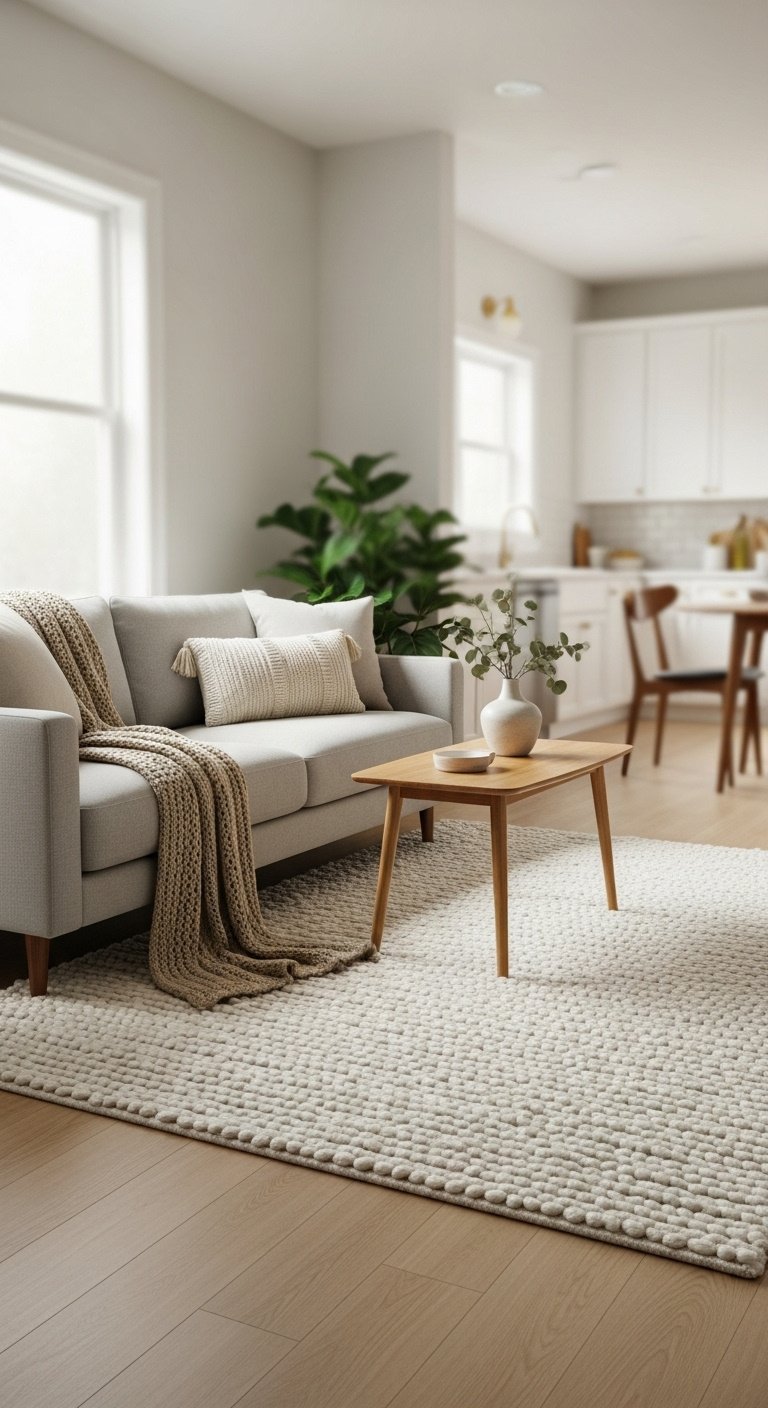
Pin this rug placement guide for your next design refresh!
2. Furniture as Architecture: Create “Invisible Walls”
You can create powerful “invisible walls” by strategically placing large pieces of furniture, like a sofa or a bookshelf, to act as room dividers. This technique physically and visually separates the zones, making the layout feel much more intentional and organized without blocking light or flow.
Materials Needed:
* Your existing or planned furniture (sofa, console table, bookshelf).
Step-by-Step Directions:
1. The Sofa Divide: Instead of pushing your sofa against a wall, float it in the middle of the room. Position it with its back facing the kitchen or dining area. This single move instantly creates a strong visual separation for the living room.
2. Anchor with a Console: Place a slim console table directly behind the floating sofa. This not only solidifies the “wall” but also provides a practical surface for lamps, decor, or a drop-zone for keys and mail.
3. Use an Island as a Bridge: A kitchen island with bar stools is a natural divider. It separates the kitchen’s primary work zone from the rest of the space while simultaneously acting as a social hub that connects the two areas.
4. Try an Open Bookshelf: An open-back etagere or bookshelf can act as a permeable screen. It effectively divides the space while still allowing light and sightlines to pass through, maintaining that airy, open feeling.
Lesson Learned: Avoid pushing all furniture against the walls. ‘Floating’ key pieces like the sofa is the number one trick to making an open-concept layout feel intentional and zoned.
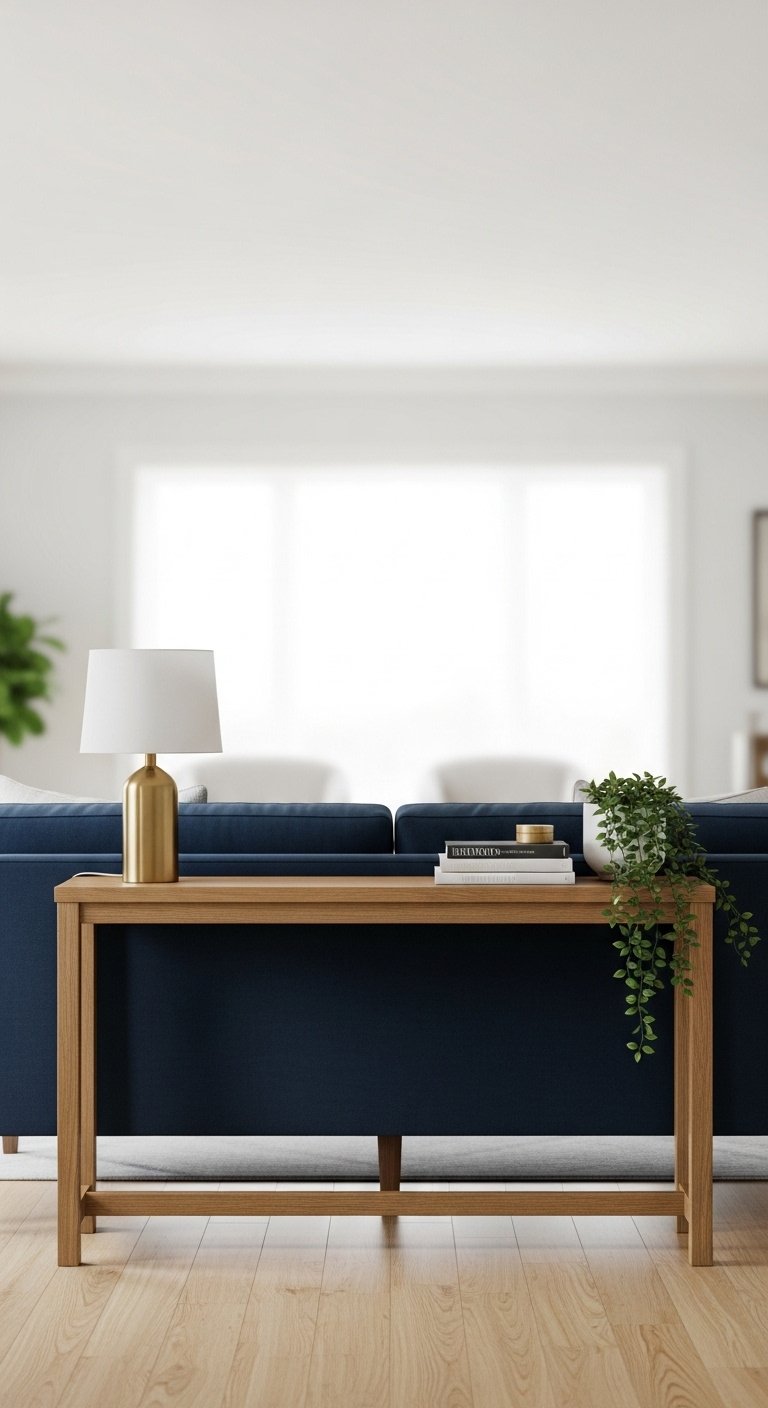
Love this layout? Save it to your ‘Small Home Living’ board!
3. The Power of Palette: Unify with a Cohesive Color Scheme
The key to a harmonious open-concept space is using a consistent and limited color palette that flows through all zones. This creates a seamless visual connection, making the entire area feel larger, more cohesive, and intentionally designed.
Materials Needed:
* Paint swatches
* Inspiration photos
Step-by-Step Directions:
1. Choose a Dominant Neutral: Select one light, neutral color—like a soft white, light grey, or warm beige—to use on all the main walls throughout the entire open space. This creates a seamless backdrop and enhances the feeling of spaciousness.
2. Select Two Supporting Colors: Pick one or two complementary or accent colors that you love. These will be your secondary and accent shades.
3. Repeat, Repeat, Repeat: The trick is repetition. Sprinkle your chosen accent colors throughout all three zones. Use them in the throw pillows on the living room sofa, the placemats on the dining table, and a vase or stand mixer in the kitchen. This repetition ties everything together.
4. Match Your Metals: Keep hardware and finishes consistent to create another layer of cohesion. If you have matte black cabinet pulls in the kitchen, echo that finish with a black-framed mirror or a floor lamp in the living room.
Pro-Tip: Use the 60-30-10 rule: 60% of your space is the dominant neutral (walls), 30% is a secondary color (like upholstery or rugs), and 10% is your accent color used for small decor items and art.

Find your perfect color combo! Pin these palette ideas.
4. Set the Mood: Layer Lighting to Define & Brighten
Layered lighting is essential for creating ambiance and defining zones by using a mix of statement fixtures, ambient lights, and task lighting. A well-planned lighting scheme can make a small space feel larger, more functional, and cozier.
Materials Needed:
* A mix of lighting fixtures (pendants, lamps, recessed lights).
Step-by-Step Directions:
1. Zone with Statement Lights: Install a key “statement” fixture over a specific zone to act as a visual anchor. A row of stylish pendant lights above the kitchen island or a beautiful chandelier over the dining table clearly defines those areas and adds a touch of drama.
2. Create Overall Ambiance: Use recessed ceiling lights on a dimmer switch for general, ambient illumination. This provides flexible, overall light that can be adjusted for any mood or time of day.
3. Add Task Lighting: Place lamps exactly where specific tasks occur. This includes a table lamp by a reading chair in the living room, or under-cabinet LED strips in the kitchen for brighter food prep surfaces.
4. Maintain a Consistent Style: To support your cohesive design, choose light fixtures that share a similar finish (e.g., all brushed brass) or style (e.g., all mid-century modern).
Pro-Tip: Putting all your lights on dimmer switches is a game-changer. It gives you ultimate control to make the space feel cozy and intimate for dinner, or bright and functional for cooking.

Light up your life! Save these lighting ideas to your home board.
5. The Double-Duty Advantage: Choose Smart, Multi-Functional Furniture
In a small space, the best approach is to select furniture that serves multiple purposes to save space and reduce clutter. Every piece should work hard, offering storage, flexibility, or a secondary function beyond its primary role.
Materials Needed:
* A curated shopping list for multi-functional pieces.
Step-by-Step Directions:
1. Opt for a Storage Ottoman: Instead of a traditional coffee table, choose a large ottoman with a removable lid. It provides hidden storage for blankets, games, or magazines, and it can also serve as extra seating for guests or a footrest.
2. Find a Lift-Top Coffee Table: A coffee table with a top that lifts up and forward can transform into a comfortable work-from-home desk or a casual dining spot for movie nights.
3. Invest in an Extendable Dining Table: A small dining table that can expand is the perfect solution for small spaces. It accommodates guests when you need it to without taking up precious real estate in your day-to-day life.
4. Consider a Stylish Sofa Bed: Modern sofa beds are a world away from their clunky predecessors. They are chic and comfortable, offering a clever guest room solution right in your living room.
Lesson Learned: When buying multi-functional pieces, always prioritize quality. A flimsy lift-top table or an uncomfortable sofa bed will cause more frustration than it solves.
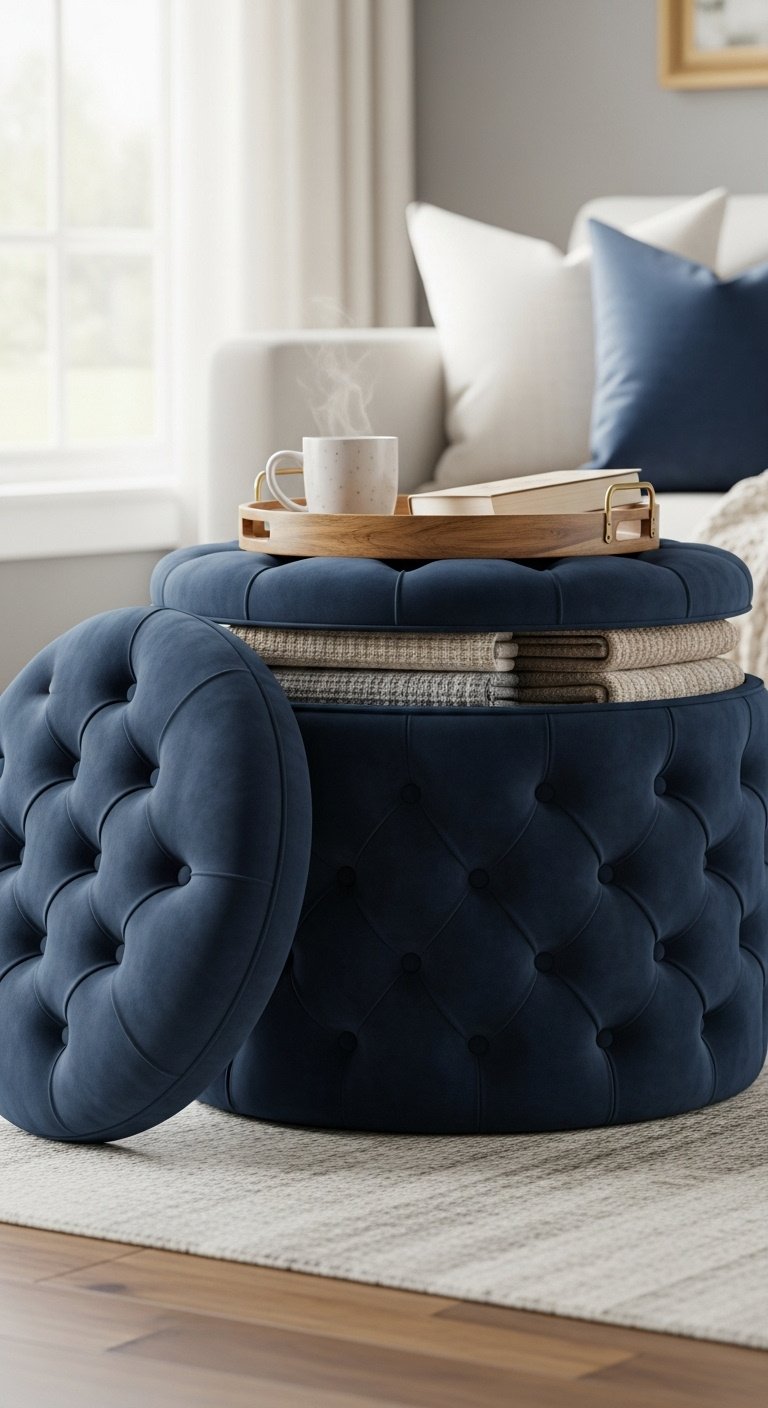
Get organized! Pin these smart furniture ideas.
6. Think Up: Maximize Your Wall Space with Vertical Storage
The key to freeing up floor space and making a room feel taller is to utilize your vertical space for storage and display. By drawing the eye upward, you create an illusion of height and spaciousness while keeping clutter off the ground.
Materials Needed:
* Wall shelves, tall bookcases, or wall-mounted cabinets.
Step-by-Step Directions:
1. Install Floor-to-Ceiling Bookcases: A tall, narrow bookcase is a powerful design tool. It draws the eye upward, making ceilings feel higher. Use it for a mix of books, decor, and stylish storage bins to hide away clutter.
2. Use Floating Shelves: In the kitchen or dining area, floating shelves offer storage for everyday dishes or glassware without the visual bulk of traditional upper cabinets. This keeps the space feeling open and airy.
3. Consider Custom Built-Ins: If your budget allows, built-in shelving and cabinets that flank a doorway or frame a television can provide a massive amount of seamless, integrated storage that looks custom and high-end.
4. Hang Wall-Mounted Media Units: A floating TV console or media unit frees up floor space entirely, contributing to a lighter, less cluttered, and more modern feel in your living area.
Pro-Tip: When styling open shelves, mix functional items (like white dishes) with decorative pieces (like plants and art). Group items in threes and vary their height to create a visually pleasing and curated display.
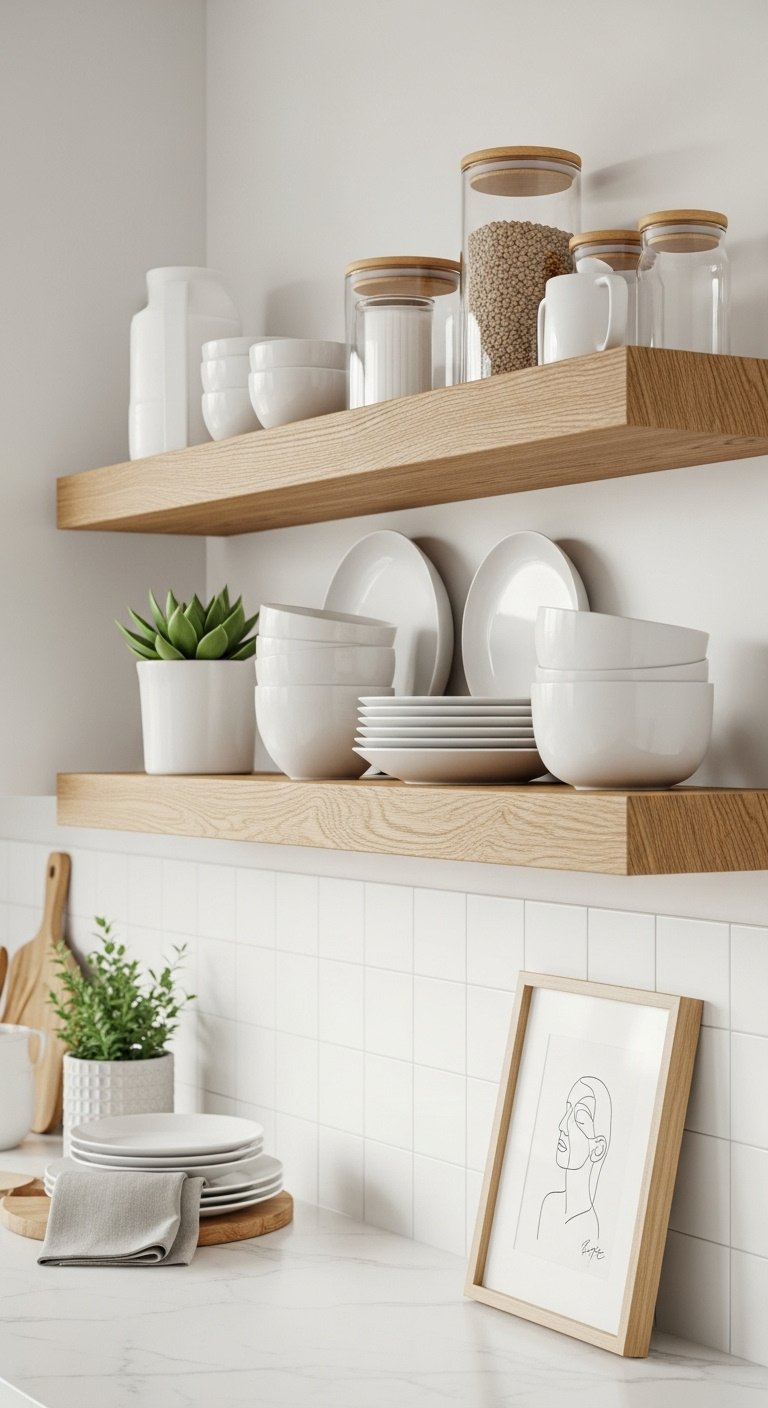
Steal this ‘shelfie’ style! Save for your kitchen inspo.
7. The Seamless Foundation: Use Consistent Flooring
The single most important element for creating a unified and expansive feel is to use one single type of flooring material throughout the entire open-concept space. This creates an unbroken visual flow that makes the area feel significantly larger and more cohesive.
Materials Needed:
* Flooring samples.
Step-by-Step Directions:
1. Choose One Material: Select a single flooring material to run from your kitchen through your dining area and into your living room. This is the most crucial step for achieving a seamless, expansive feel.
2. Prioritize Durability: Opt for materials that can handle the different demands of each zone—from kitchen spills and traffic to living room comfort. Luxury Vinyl Plank (LVP), modern laminate, and engineered hardwood are all excellent, durable choices.
3. Go Lighter for Small Spaces: Lighter colored flooring tends to reflect more natural and artificial light. This simple choice can make a small, dark space feel significantly larger and brighter.
4. Lay Boards to Elongate: Run the flooring planks parallel to the longest wall in the room. This visual trick draws the eye along the length of the boards, making a narrow space feel wider or a short space feel longer.
Lesson Learned: Many people are tempted to tile the kitchen and use hardwood in the living room. In a small open concept, this transition chops up the space visually and makes it feel smaller and more disconnected. A single flooring type is non-negotiable for creating flow.
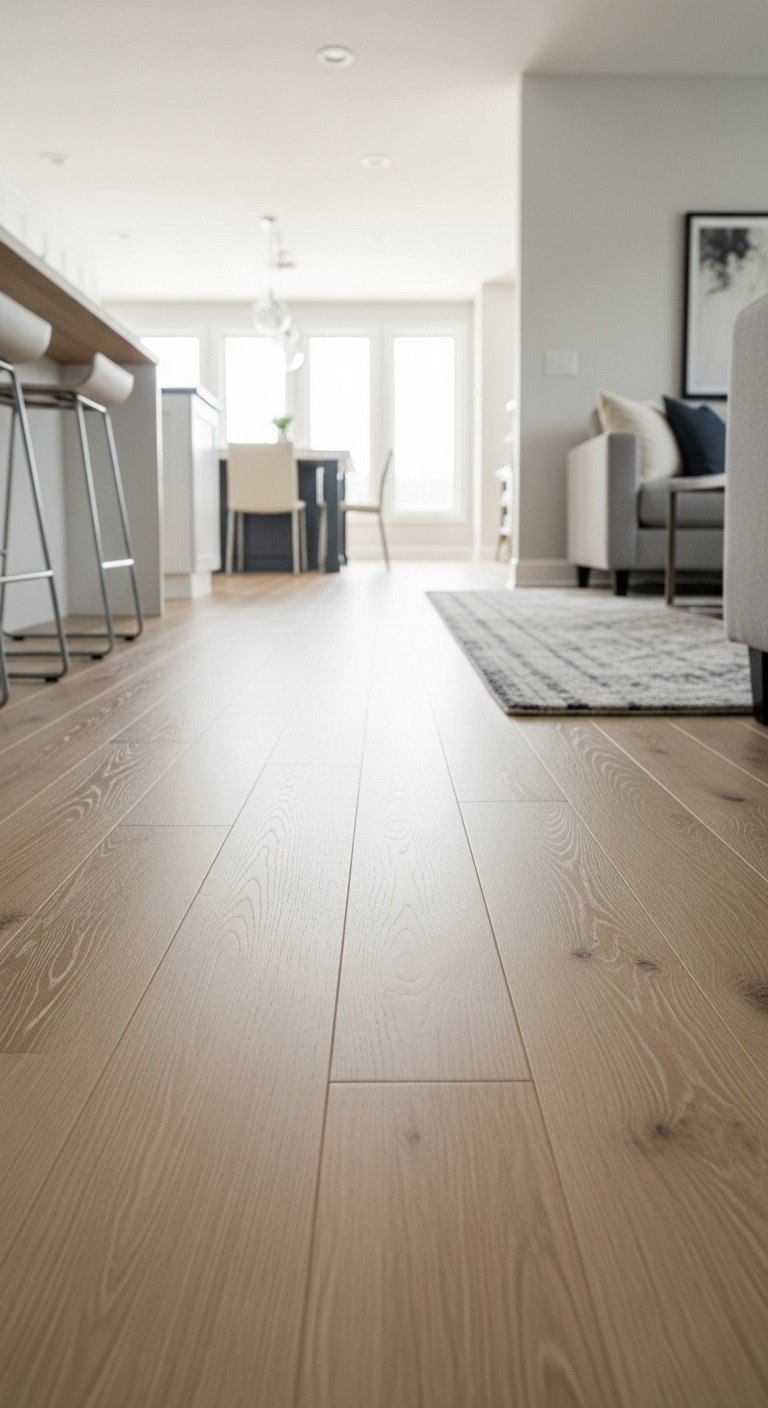
Ready for a reno? Pin these flooring tips for later!
Key Takeaways: Your Quick Guide to a Flawless Open-Concept Space
Feeling inspired but want a quick recap? Here is your cheat sheet for creating a beautiful and functional small open-concept kitchen, dining, and living room.
- Define Zones: Use area rugs and furniture placement (like a “floating” sofa) to create distinct areas without walls.
- Stay Cohesive: Stick to one flooring type and a consistent 3-color palette throughout the entire space to create a unified feel.
- Be Smart with Furniture: Choose multi-functional pieces (storage ottomans, lift-top tables) and appropriately scaled items to maximize every inch.
- Think Vertically: Draw the eye up and add storage with tall bookcases or floating shelves to make the room feel larger.
- Layer Lighting: Use a mix of statement pendants, ambient ceiling lights, and task lamps to define zones and set the mood.
People Also Ask About Open-Concept Living
Is an open kitchen with a living room a good idea for a small space?
Yes, an open kitchen with a living room can be a fantastic idea for a small space. An open concept makes a small area feel significantly larger, brighter, and more social by removing visual barriers and improving the flow of natural light. The key to success is using smart design strategies, like defining zones with rugs and furniture, to prevent the area from feeling like one cluttered, undefined room.
How do you arrange furniture in a small open-concept living room and kitchen?
Start by creating a focal point in the living area, such as a media center or a large window. Arrange your main seating (sofa, chairs) around it, using a large area rug to anchor the entire grouping. A critical move is to “float” the sofa away from the wall, with its back facing the kitchen, to create a clear visual divider. Always ensure you maintain clear traffic paths, at least 36 inches wide, between the different zones for easy movement.
What is replacing the open-concept trend in 2025?
While open-concept living is still extremely popular, there is a growing trend towards “broken-plan” or “zoned” living in 2025. This design philosophy keeps the airy feel of an open plan but strategically uses elements like half-walls, glass partitions, large bookcases, or distinct flooring and ceiling treatments to create more defined, cozy, and private nooks within the larger space. It’s a hybrid approach that offers the best of both worlds.
How do you deal with kitchen smells and noise in an open floor plan?
This is a crucial practical consideration that requires a two-pronged approach: ventilation and absorption. For cooking smells, invest in a high-quality, powerful range hood that vents directly to the outside—this is non-negotiable. For noise from appliances and conversation, incorporate soft, sound-absorbing materials throughout the space. This includes large area rugs, upholstered furniture, thick curtains, and even acoustic wall panels that can be disguised as art.
Final Thoughts
Transforming your small open concept kitchen, dining, and living room from a source of frustration to a space you love is entirely within your reach. It’s not about following rigid rules but about understanding the core principles of zoning, cohesion, and functionality. By using furniture as architecture, unifying the space with color and light, and choosing smart, hardworking pieces, you can create a home that is both beautiful and perfectly suited to your lifestyle.
Which of these ideas are you most excited to try in your home? Let me know in the comments below
